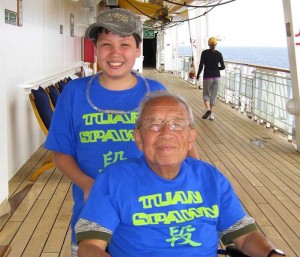On our first visit to the Museum of Fine Arts last year, our tour guide Jake asked the boys, “Do you know the three rules of an art museum?”
Ezra responded quickly and exuberantly. “No violence!”
“Okay – four rules,” Jake replied while laughing.
I don’t know what kind of kids Jake normally gets at the museum, but for my boys No Violence has to be at the top of the rule list. They just can’t keep their hands off of each other. They sleep in a tangle of legs and arms many nights. If there are five square feet somewhere, they manage to turn them into a wrestling ring. Sometimes, though, someone pushes a little too hard and all of that physicality turns ugly, with lots of tears, bruises, and accusations. And if Ezra is the least bit upset with Zach, he scratches, kicks, and hits.
Zach, on the other hand, can usually hold it together. That is, until he loses. Or he is threatened with losing. Then he falls apart. He starts hissing, wells up with tears, and literally growls at his opponent. My rule-following, good boy can even turn into an ugly little cheater if it will help avert loss.
In just the last week, he threw a tennis racket across the court; he called a new board game, “the stupidest game ever;” and he said of the evil soccer team who beat his team, “If they want a fight, we’re gonna give them a fight!” We don’t tolerate his fits; I pull him off the field, send him to bed without dessert, take away his allowance, and cancel cherished play dates. All to no avail. Very little makes me feels as incompetent as Zach’s inability to be a gracious loser.
According to Ellen Galinsky, in Mind in the Making, what both of my boys need is help with perspective taking, the second on her list of Seven Essential Life Skills. She writes that for twenty years, educators believed that to reduce aggression in school-aged children they should teach problem-solving skills. Instead, new research indicates that the far more effective way to reduce aggression is to promote perspective taking.
Even if your kids don’t beat the crud out of each other or take vows of hatred toward the other team, you’ll want to promote perspective taking. It’s been shown to predict better reading ability and better pro-social behavior.
When we talk about perspective taking, we are not talking about a fuzzy kind of empathy, although I would take more of that from the boys. We are talking about the executive functions of inhibiting our own thoughts and feelings to take on those of others; the cognitive flexibility to see things in more than one way; and the ability to reflect on the differences and similarities between our perspective and that of others.
One of Galinsky’s suggestions to improve perspective taking is to undertake lots of pretend play and discussions of how characters are feeling at points in the story. Some days, like all of the days this week, I give up hope that we can do much to help. Plus, I hate pretend play and role playing. But I’m gonna do it. And I’m gonna take out our social stories books again. And I’m gonna ease up on some homeschool curriculum to make room for all of it. Better to help the boys avoid becoming Genghis Khan than to study him, yes?












